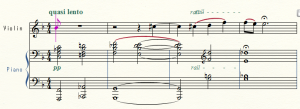Second Movement
Allegro (Sonata form)
After a very impressive 4 measure introduction, the first theme (Theme1) is presented by a piano as shown in Fig.1 which I modified for simplicity.
M2 is presented as Theme1 of sonata form. M2 includes 3 upward motives and it has a strong impulsive character. Theme1 is presented by the piano and followed by unison of the piano and the violin. Then a transition section follows as shown in Fig.2
Fig.2 bar 24

After a phase shown in Fig 3, which is played by the violin with pp., Theme1 comes back with ff.
Fig.3 bars 30
![]()
It would be a hard work for pianists to prepare this pp. According to Franck’s indication, pp is required by dim subito in the bar 28 against a crescendo starting from the bar 26. To realize this indication in tempo looks extremely difficult.
Thema1 comes back at bar 34, and M1 which is the basic motive from the first movement appears with “sempre forte e appasionato’ like a triumphal fanfare. (Fig.4) In the first movement, M1 had a mild and unstable character and it had asking something. Here, M1 is declaring “I am right”
Theme1 section connects to Theme2 section with ritardando.
The second theme (Theme2) sounds free and easy. It has a good contrast to Theme1 and it is played in one stroke by the violin for 19 bars.
Thema2 ends ant bar 66 with rallentando. Codetta starts in poco piu lento by the violin as shown in Fig.6. The exposition is closed in the drifting mood tinted by resounding Theme2.
Development:
There is no repeat mark at the end of Exposition, but the composer is successful to give the feeling of repeat by his superb technique.
As shown below, 4 half notes in quasi lent is a modified M2 and symbolizes Theme1. Franck did not use M2 but he used the chord procession of Theme2 instead. After this phrase, he connects the phrase from Codetta. In this way he reminded listeners and players of the Exposition section and the style of sonata form.
Then “Tempo I allegro” follows and a development section actually begins from bar 94.
Development section mainly proceed with the combination of the piano which presents M2 (Modified) and the violin which replies to M2 with fantastic recitativo. After the piano plays Theme2, stretta by M2 appears and it leads music to a climax. Recapture starts from bar 136.
Recapitulation:
As shown in the Music Analysis, There is not much to comment on the recapitulation section.
Coda:
Coda is led by a motive from Primary Theme as shown in Fig 8 Mes.202 with ‘animato poco a poco’ . Then modified Primary Theme is played by violin and piano in a tense mood. From measure 217 M1 appears abruptly with “ poco slargando” and 2nd movement finish brilliantly.
Fig.8 Mes.202
|
2nd Movement |
||||||
|
Exposition |
Introduction |
1 |
– |
3 |
3 |
|
|
Theme1 |
4 |
– |
13 |
10 |
Main Theme of 2nd Mov |
|
|
Theme1 |
14 |
– |
23 |
10 |
||
|
Passage1 |
24 |
– |
29 |
6 |
||
|
Passage2 |
30 |
– |
33 |
4 |
||
|
Theme1 |
34 |
– |
43 |
10 |
||
|
Passage3 |
44 |
– |
47 |
4 |
from M1 |
|
|
Theme2 |
48 |
– |
67 |
20 |
Free Malody ends by M1 |
|
|
Closing |
66 |
– |
79 |
14 |
||
|
Development |
Thema1 |
80 |
– |
87 |
8 |
Abridged Thema1 Basic Motive M2 |
|
Closing |
89 |
– |
93 |
5 |
||
|
Thema1 |
94 |
– |
101 |
8 |
||
|
Closing |
102 |
– |
109 |
8 |
||
|
Theme1+ |
109 |
– |
116 |
8 |
||
|
Theme1+ |
116 |
– |
127 |
12 |
||
|
Thema2 |
127 |
– |
130 |
4 |
||
|
closing |
130 |
– |
137 |
8 |
||
|
Recapture |
Theme1 |
138 |
– |
147 |
10 |
|
|
Passage1 |
148 |
– |
153 |
6 |
||
|
Passage2 |
154 |
– |
157 |
4 |
||
|
Theme1 |
158 |
– |
167 |
10 |
||
|
Passage3 |
168 |
– |
171 |
4 |
from M1 |
|
|
Theme2 |
172 |
– |
191 |
20 |
||
|
Closing |
191 |
– |
202 |
12 |
||
|
Coda |
Theme1 |
202 |
– |
217 |
16 |
|
|
Closing |
217 |
– |
222 |
6 |
||
|
Coda |
222 |
– |
229 |
8 |
||



